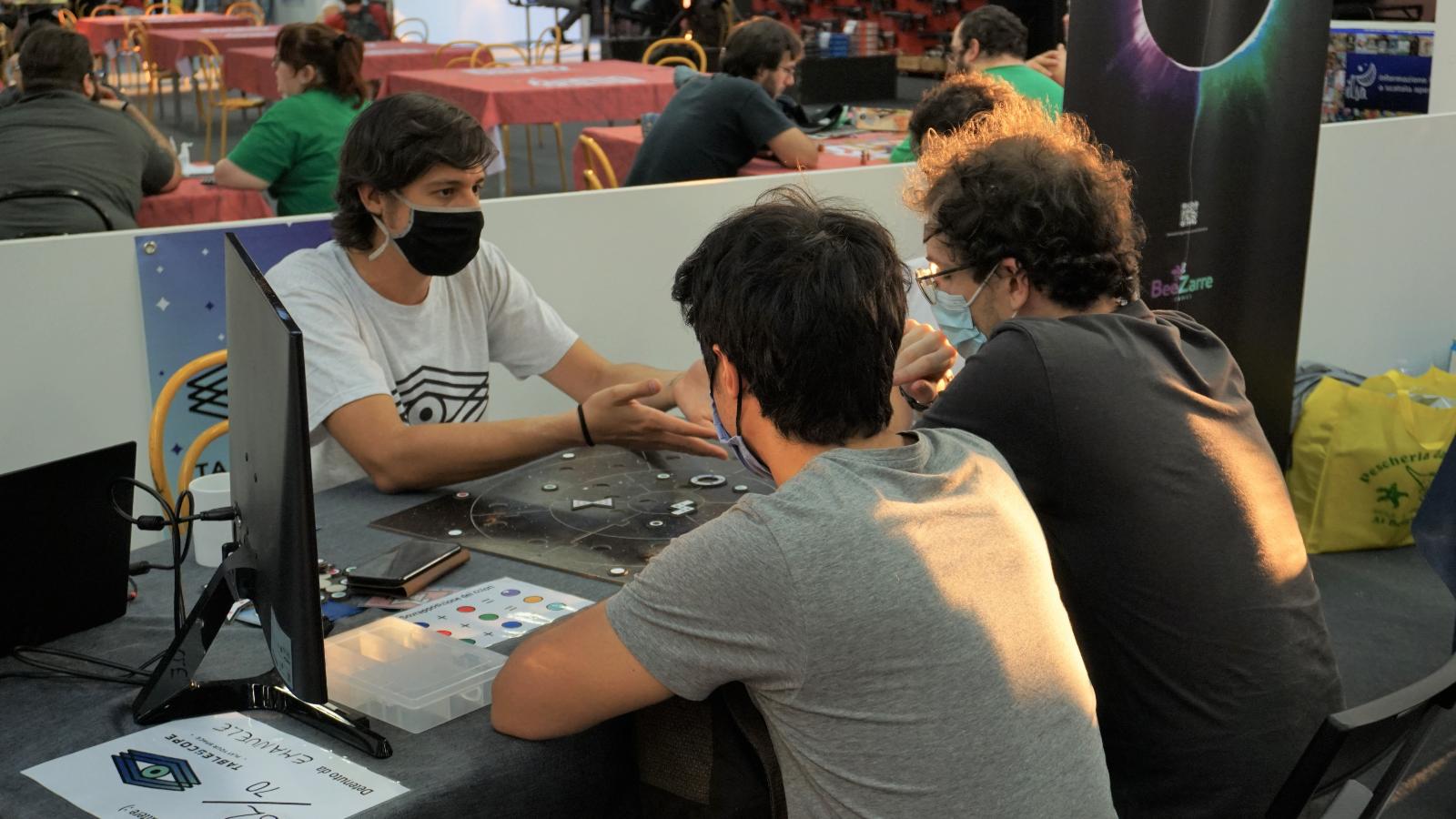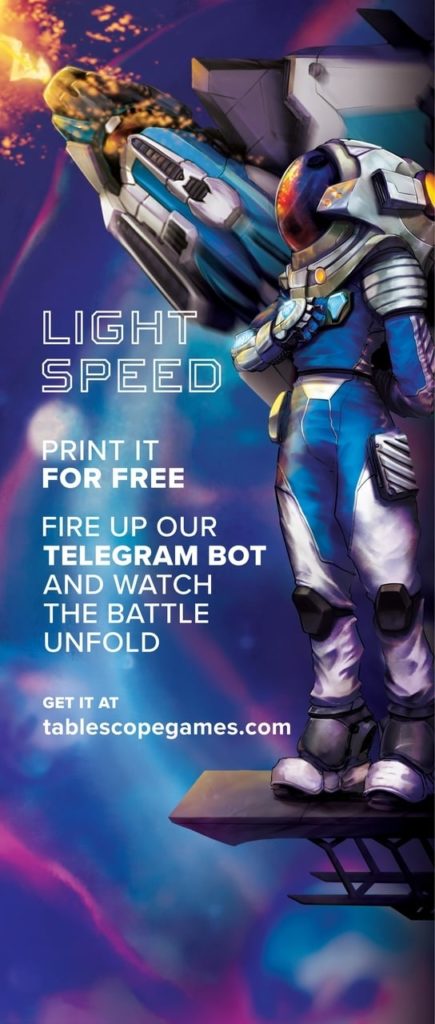Over the past month and a half, we have taken our prototypes to four different trade shows.
Play in Modena, Maker Faire in Trieste, Romics in Rome, and finally Spiel in Essen were the scenarios where we stress-tested our prototypes for the first time on a larger scale.
In this post I have collected some thoughts on the more practical and organizational aspects that come into play when attending a fair event. It is not an exhaustive list, but maybe something comes in handy if at some point you will be setting up a booth for the first time.
1. Write the organizers
This seems like an obvious point. And in some respects it is.
In my experience, the information about exhibit spaces that you can gather from the trade show website is often incomplete. And it stands to reason that they are: booking a booth is not like choosing an item from Amazon.
Write an email explaining your requirements and see what they have to say. Even the deadline for inquiries may be unclear. All the more reason to send a message right away.
Worst case scenario, you will have started a conversation that could come in handy for the next edition of that event.

Already in 2020 we had started to ask around about exhibit possibilities at the Play and Spiel festivals, then the pandemic stifled everything. Despite this, we found ourselves the following year with quite a bit of material already collected, a list of contacts and a much more accurate idea of costs.
2. Gather information about the exhibit spaces and materials provided
Especially if you are not booking a stand-alone booth but rather one or more tables in a common area, it is important to understand how your space is organized.
Will there be walls on which to post up graphics? How many? Where exactly is the booth/table located? Are tables and chairs included? If so, how many and how large?

There are a thousand reasons to gather as much detailed information as possible about the space you will be occupying. Some are in the direction of opportunities, like organizing a creative collaboration with your booth neighbor. Others are in the direction of pragmatics, like knowing the size of tablecloths to buy.
Ah, there you go. Tablecloths are a must, otherwise the dreaded county fair effect gets triggered.
3. Make up a team that is appropriate for the size of the booth
Or choose a display solution that suits the size of the team.
With two prototypes, we have always tried to be three people presenting games and project. A setup like that allows you to have demonstrators at the tables and at the same time someone to explain what is going on to people who stop to watch a game in progress. Or it simply allows a team member to take a breath without leaving demo tables unattended.

The few times when it was just the two of us, we could feel the difference! After all, that is 8-10 hours of intense work. Presenting your board game is always rewarding, but it is also an activity that consumes energy in direct proportion to the passion that animates it <3
4. Appearance matters
It would be naive to argue that the appearance of a board game box does not make a difference. The same goes for a booth.
Do not leave bags or items scattered around, get suitable tablecloths (those tablecloths again!) and prepare graphics that identify your space, possibly with a brief description of the game or project, website link, and social icons.
During the first three fairs, we got away with printing t-shirts, a few mugs, and banners describing the project. More people than I would have expected stopped to read them, even though the positioning behind the tables was not optimal.
For Essen we also prepared two roll-ups about the Light Speed print&play in collaboration with the illustrator who did the art for the cards. We used them to create a space-themed corner where you could try the game on a galactic playmat.

The impact was extremely positive.
5. Devote to each person the time they deserve
There will always be someone who stops to look at the booth and then moves on because demo tables and staff are busy. Maybe that person would have bought the game while the player sitting at the table is explaining in detail why they will never buy it.
It does not matter! Such situations are physiological. Rather, exchange everything you can with the person in front of you.

Even if a rep from a big publishing house shows up or that influencer with 100k followers stops by, you should finish up talking or playing with whom you are already talking or playing. If the rep or influencer do not understand this approach, then maybe they are not someone worth working with.
6. Be realistic about goals
This goes through defining them first, the goals. What do you expect from that event? You might just want to playtest the game or collect email addresses before a Kickstarter launch. Or maybe you have a goal on the number of boxes sold.
Either way, you should aim for realistic outcomes and honestly assess whether it is worth attending the event based on the costs involved.
Of course, if it is the first trade show you attend, it is hard to say what is realistic and what is not, but an estimate is always possible. How long does a game demo last? How many hours will you be at the event? Are there any incentives for a player to subscribe to the mailing list or buy the game even though they have not tried it?

In next week’s article I will share a quantitative analysis of the results we achieved and the costs we incurred over the four festivals.
7. Different event, different audience
No two festivals are ever the same. Neither are two board game festivals.
Location, the month of the year, opening hours, cost, theme. Many factors influence the audience we have in front of us.
From board game experts to casual gamers, from avid role-players to those who found themselves there by chance because they had to accompany their little brother. Communication and expectations must align with the new audience.

To give some examples, in Essen several participants preferred not to share their email address, although they decided to take note of the project or follow it on social media. In Trieste it was packed with grandmothers and children 😀 At Romics there were many kids, who had come for manga but had never played modern board games.
Exposing yourself to this diversity is a great opportunity to understand in which scenario your game works best.
8. Make business contacts
The reason to participate in a trade show is not only to meet players but also to create connections with other professionals.
As for us, we had scheduled appointments with a couple of board game manufacturers but the most interesting meetings were those that happened without planning.

We scouted out a couple of booths where other digital hybrid projects were being presented, got a visit from David Cicurel (Chronicles of Crime), exchanged opinions with professional UX designers, found a volunteer for a possible translation into Dutch, chatted with the director of an important Italian magazine about board games, received a nice proposal from the manager of Dal Tenda and so on.
And these meetings were not planned, but we made sure to take advantage of the opportunity when it manifested.
It is always a good time to talk to game manufacturers, fellow game designers, publishers, illustrators, influencers, and translators. The important thing is to be clear about the status of the project and the direction we have in mind for its development.
Again, at worst we will end up with a handful of contacts ready to be pulled out of the hat when needed.
9. Do not let your guard down
Repeatedly performing the same action can cause a drop in quality, attention, or creativity. This is how relationships become boring or the beginner loses their luck.
If things have gone well in previous events, do not let your guard down!
As for us, before Essen we bought a set of legs that did not match the tabletops. Fortunately, an expedition to the hardware store and a little ingenuity was enough to resolve the issue. But it could have been worse than that.

I then put the load on it myself, leaving one of the power cords for the screens at home. After buying a universal power supply, which was not universal enough though, we first got away with showing the outcomes of Kosmykes games on the laptop. Then on the second day, we bought a new screen.
Again, no critical failures, but best to avoid getting into situations like this.
10. Perfection does not exist
For every solution found, there will be another improvement left out.
For example, once we arrived in Essen, we realized that many exhibit spaces had installed spotlights on the partition walls, and the result was noticeably more professional. When we went to the hardware store to buy the missing screws, we also picked up a pair of clip-on lights.

On the other hand, most of the exhibitors had a layer of carpet laid out on the floor to make the booth space more inviting. While we would have liked that, we did not have a way to get it.
The Spiel went well, even though we did not have carpeting.
Related articles
In the next article, I am going to talk about how many email addresses we collected in preparation for our Kickstarter campaign over the four events. Besides, I am going to share the costs we incurred to attend the trade shows.
In the meantime, if you are interested in learning more about Tablescope’s mission, read ‘2 Pros and 2 Cons of Running a Start-up that Develops Digital Hybrid Games‘. On the other hand, if you want to create a landing page before attending a trade show, check out the tutorial ‘How to Create a Board Game Landing Page with WordPress: Free Resources and Essential Plugins‘.


